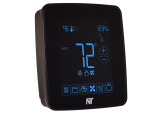Sizing/Selecting A Damper Actuator

The Belimo 10 Step process for sizing and selecting a damper actuator:
- 1)What is the Area of the damper?
We need to find the height and width of the damper. The customer may provide this in millimetres (mm). If so, multiply the millimeters by 0.039 to convert it into inches. Once in Inches, multiply the height and width and divide by 144 to get the area in square ft (sq. ft). If the customer provides it is Feet (ft), no need to convert it to inches. The height and width can just be multiplied to get the area in sq. ft.
If it is a round damper, we calculate the area with the formula:
Area (sq. ft) = (3.14*r2)/144
- 2)What type of blades are being used?
Does the damper have Opposed blades or Parallel blades?
- 3)Are there seals on the damper blades?
Seals create an extra torque requirement on the damper. It has a tighter seal, so it needs more torque to overcome this. The seals are typically used in applications where you don’t want air leakage like an outdoor air damper.
- 4)Does the manufacturer of the damper have a rated torque rating?
Sometimes the manufacturer of the damper will provide a rated torque rating for the damper. If not, specified then we go with the standard sizing methods laid out in this document.
- 5)What is the velocity of the air going through the damper?
The velocity with effect the amount torque that is required. The higher the velocity, the higher the amount of torque is required to overcome the air when opening or closing the damper. To calculate for this additional torque, we add in a torque loading factor. This torque loading factor is taken into consideration if the damper has seals or not and what the velocity is. The torque loading factors are as follows:
We play mostly in the <1000 FPM as this is commercial HVAC use. When we go above that, it gets into more industrial applications. If the customer doesn’t provide this information, we use the <1000 FPM. In addition, if the customer is unsure if there are seals and what type of blades they are, we go with the worst case scenario to be safe. That will be parallel blades with seals, which is a torque loading factor of 7.
Now it is time to calculate the torque. The formula is as follows:
Damper Area (sq. ft) x Torque Loading Factor = Required in-lbs of torque.
[Ex. Damper Area (8 sq. ft) x Torque Loading Factor (Parallel without Seals – 4) = 32 in-lbs]
- 6)Now getting into the Actuator requirements. Is Fail Safe required?
Does the actuator have to be Fail Safe (Spring Return or Electronic Fail Safe) or Non-Fail Safe? (Ex. An outside air damper will want to be Fail Safe just in case there is a power outage, the damper is then not stuck open allowing cold outside air in.)
- 7)What is the power supply?
What is the actuator being powered with? 24 volts, 120 volts or 230 volts?
Most modulating actuators are a 24 volt power supply. Our on/off and floating point actuators have more selection on the power supply. We also carry universal power actuators which have the UP in the model number (Ex. NFBUP). These can work with any of the three power supplies, 24 volts, 120 volts or 230 volts. There is nothing that needs to be adjusted or programmed on the actuator. The customer just powers the actuator and the universal power supply on the circuit power will recognize the power supply being supplied.
- 8)What type of control signal is required?
How is the actuator being controlled?
- 9)Are we direct coupling the actuator? (Direct Coupling = Installing it on the shaft of the damper)
If not, we will have to select some mounting accessories.
- 10)Are there any additional accessories required?
Does the customer require any additional accessories like auxiliary switches or enclosures?
Recent Posts
-
Victoria Day
History of the Sovereign's birthdayThe Sovereign's birthday has been celebrated in Canada since the …2024 May 14th -
Wi-Fi Thermostats by Network HVAC Thermostat
The Net/X X7 Wi-Fi thermostat family is the perfect solution for a wide variety of HVAC control need …2024 May 14th -
Spartan Peripheral Devices Valve Selection Guide
1.SELECT YOUR VALVE BODY• Female Thread• Male Thread• Sweat• Single Union• Double Union2.SELECT YOUR …2024 May 13th

